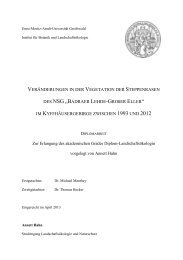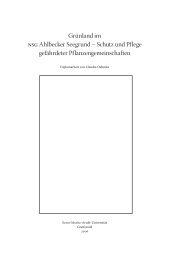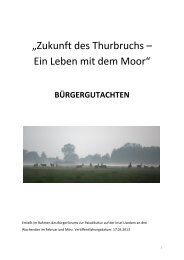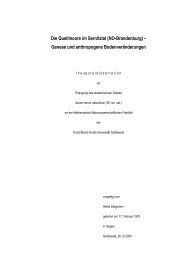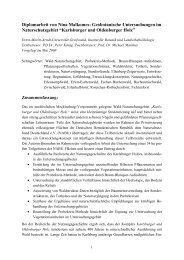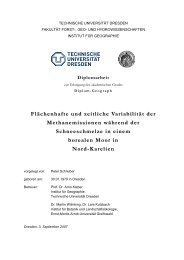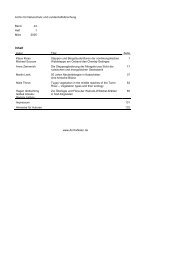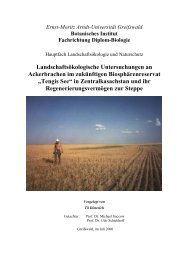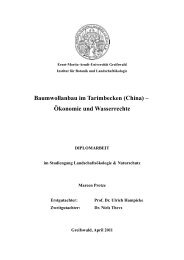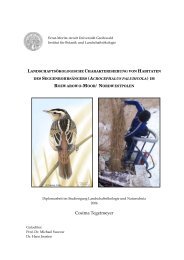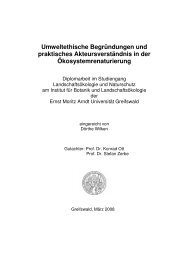Management model for habitat *6260 Pannonic sand steppes
Management model for habitat *6260 Pannonic sand steppes
Management model for habitat *6260 Pannonic sand steppes
Create successful ePaper yourself
Turn your PDF publications into a flip-book with our unique Google optimized e-Paper software.
<strong>Management</strong> <strong>model</strong> <strong>for</strong> <strong>habitat</strong> <strong>*6260</strong><br />
<strong>Pannonic</strong> <strong>sand</strong> <strong>steppes</strong><br />
Viera Šefferová Stanová<br />
DAPHNE Institute of Applied Ecology, Slovakia<br />
Zoltán Vajda<br />
Kiskunság National Park, Hungary<br />
7th European Dry Grassland Meeting
<strong>Management</strong> Models<br />
<strong>for</strong> Natura 2000 Sites<br />
EC project - elaboration of 25 management <strong>model</strong>s <strong>for</strong><br />
<strong>habitat</strong>s from annex I of the Habitats Directive, which require<br />
active recurring management<br />
Grassland <strong>habitat</strong> types covered: 6210, *6220, *6230 , <strong>*6260</strong><br />
Compilation of published and unpublished experience and<br />
best practices<br />
Approach: single <strong>model</strong> <strong>for</strong> each <strong>habitat</strong> type, which requires<br />
management<br />
http://ec.europa.eu/environment/nature/natura2000/manag<br />
ement/<strong>habitat</strong>s/<strong>model</strong>s_en.htm
<strong>Management</strong> <strong>model</strong>s<br />
<strong>for</strong> grassland <strong>habitat</strong>s<br />
Preparation of 16 management <strong>model</strong>s <strong>for</strong> all grassland<br />
<strong>habitat</strong>s in Slovakia<br />
Including results of ecological experiments focused on<br />
mulching, grazing, mowing, top soil removal etc.<br />
First step: analysis of ecological conditions and management<br />
requirements of particular vegetation types (alliances).<br />
Result is 16 management <strong>model</strong>s <strong>for</strong> 23 alliances of<br />
grassland vegetation
<strong>*6260</strong> <strong>Pannonic</strong> <strong>sand</strong> <strong>steppes</strong><br />
Description of <strong>habitat</strong> and related species<br />
Open <strong>sand</strong> grassland communities dominated by Festuca<br />
vaginata and Stipa borysthenica<br />
Closed <strong>sand</strong> <strong>steppes</strong> are characterised by a vegetation<br />
cover of more than 50%. These <strong>habitat</strong>s are typified by<br />
Festuca wagneri and Festuca rupicola,<br />
Endemic <strong>habitat</strong> of the Pannonian biogeoregion
Distribution of <strong>*6260</strong> <strong>Pannonic</strong><br />
<strong>sand</strong> <strong>steppes</strong> in Natura 2000 sites
Species that depend on the <strong>habitat</strong><br />
Dianthus diutinus<br />
Natural <strong>habitat</strong>s in their original<br />
state are rare due to the effects<br />
of fragmentation and isolation<br />
It is resulting mainly from<br />
<strong>for</strong>estry activities.<br />
There are less than 10 known<br />
sites in Hungary.
Trends<br />
Sand <strong>steppes</strong> and shifting <strong>sand</strong> areas are considered to be<br />
one of the most endangered <strong>habitat</strong>s in Central Europe.<br />
At the beginning of the 20th century, <strong>sand</strong>s were still<br />
widespread,<br />
now they have been reduced dramatically through<br />
now they have been reduced dramatically through<br />
stabilizing measures, intensive agricultural and <strong>for</strong>estry use<br />
and abandonment of traditional land use.
Threats<br />
Abandonment - litter accumulation and the establishment<br />
of shrubs and trees, humus accumulation stimulates the<br />
spread of generalists and may cause the local extinction of<br />
some open <strong>sand</strong> grassland species<br />
Overgrazing - grazing by large flocks can lead to the<br />
Overgrazing - grazing by large flocks can lead to the<br />
undesirable spread of ruderal or alien plant species and<br />
erosion on the dunes
Threats<br />
Af<strong>for</strong>estation – Pinus sylvestris, which is not native to the<br />
<strong>habitat</strong> and have had a very negative impact on basic <strong>sand</strong>s<br />
because of acidification<br />
Invasion and/or plantation of non-native species - Robinia<br />
pseudacacia, Asclepias syriaca, Ailanthus altissima, Prunus<br />
serotina
Conservation management<br />
Sand <strong>steppes</strong> could be maintained without management if<br />
the ecological conditions allow wind erosion, which keep<br />
moving of shifting dunes<br />
Sand dunes have been stabilised to such extent that without<br />
appropriate management it leads to natural succession or<br />
invasion by expansive grasses and alien species.
Active management - grazing<br />
The open steppe community Festucetum vaginatae does not<br />
need grazing.<br />
On closed dunes it is mostly sheep that are used, while on<br />
plains it is cattle.<br />
For the maintenance of open and closed grasslands on <strong>sand</strong>,<br />
1 sheep per ha <strong>for</strong> 2 days a year is recommended<br />
In areas where af<strong>for</strong>estation through succession is a<br />
problem, mixed sheep/goat herds can be used.<br />
High grazing pressure <strong>for</strong> a short period of time eliminates<br />
not only young poplars but also grass species, and reestablishes<br />
mobile dunes - 10 goats/ha, and 3 sheeps/ha.
Active management - mowing<br />
• Mowing is nearly impossible on open <strong>sand</strong> <strong>steppes</strong>; it is<br />
more typical <strong>for</strong> closed <strong>steppes</strong>.<br />
• Steeper slopes and areas containing rare species should not<br />
be mowed with machinery, due to erosion problems.<br />
• The machinery should cut the vegetation a minimum of 10<br />
• The machinery should cut the vegetation a minimum of 10<br />
cm above the soil surface to protect tussock <strong>for</strong>mation by<br />
dominant grass species.
Eradication and control of invasive<br />
species – Robinia pseudoacacia<br />
• Drilling a 4-7 cm deep hole, with an 8 mm diameter, into the<br />
tree.<br />
• The direction of the borehole has to point not to the centre<br />
of the tree but must run nearly parallel with the bark at a<br />
10° angle to the xylem.<br />
• The hole must be completely filled with herbicide<br />
(Glyphosat), and then has to be sealed with lime putty.<br />
• The number of holes depends on the size of the tree. There<br />
has to be one hole <strong>for</strong> every 10 centimeters of the trunk’s<br />
circumference.
Eradication and control of invasive<br />
species – Robinia pseudoacacia



